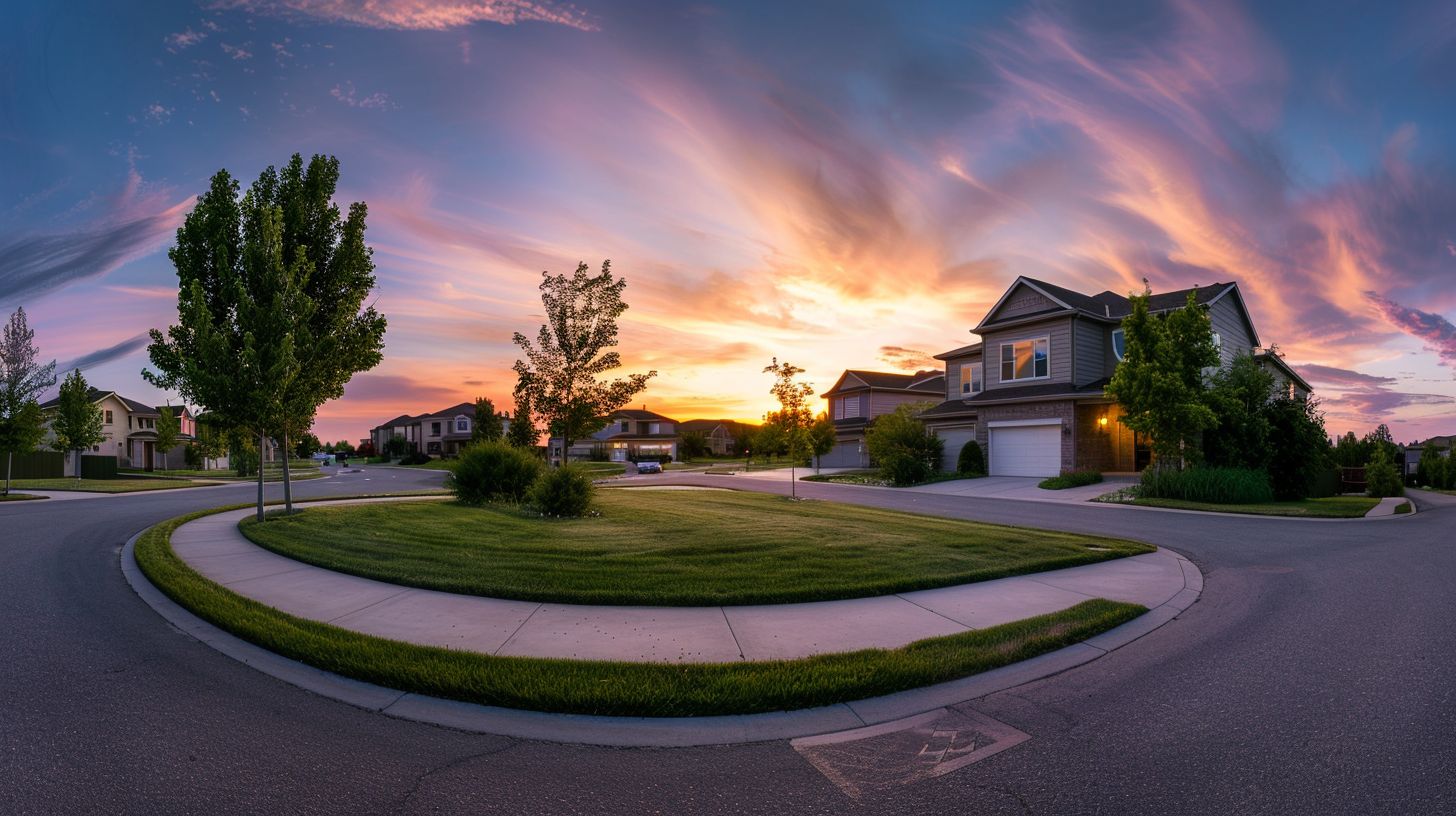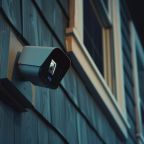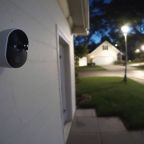Knowing how far your Ring camera can see is key to protecting your property when investing in home security. On average, these cameras have a visual range that covers up to 30 feet (9 meters).
This article will guide you through the capabilities and limitations of Ring cameras, helping you optimize their placement for maximum security. Don’t guess – let’s explore the facts!
Key Takeaways
- Ring cameras can see clearly up to 30 feet (9 meters), with motion detection also reaching this distance under ideal conditions. Night vision capability allows them to capture video in complete darkness using infrared technology.
- Wi-Fi strength significantly affects the performance of Ring cameras; a strong signal is needed for reliable video streaming and data transmission, ideally within 20-30 feet (6-9 meters) of the router.
- Privacy features on Ring devices include customizable motion zones, privacy zones that block recording in certain areas, audio toggles to disable sound collection, and blue lights indicating active recording.
- Motion detection uses infrared sensors to differentiate between human beings and insignificant movements. Users can set specific monitoring zones for more precise alerts.
- Comparatively speaking, other security cameras may offer longer night vision ranges or broader compatibility with various smart home systems than Ring cameras.
Understanding Ring Camera Distance Capabilities
When it comes to home security, knowing the reach of your Ring Camera is crucial. Let’s dive into the specifics of how far these devices can effectively monitor your space, ensuring nothing goes unnoticed on your watch.
Visual range of Ring cameras
Ring cameras are powerful tools for monitoring your space. They can cast their gaze up to 30 feet (9 meters), securing a wide berth for home surveillance. However, beyond this distance, images start to lose their crispness, and details become harder to discern.
Your Ring camera is like a vigilant guard: the closer the subject, the clearer the picture.
Every corner of your property could potentially fall within sight if you place your cameras wisely. Angles are key—a well-positioned Ring device maximizes visibility and minimizes blind spots.
Obstructions are just obstacles; with strategic camera placement, they won’t stand in the way of safety or serenity in your sanctuary. Sound carries too; clear audio recording ensures you not only see but also hear what’s happening around your nest hello or away from it.
Audio detection range of Ring cameras
Ring cameras not only keep a watchful eye but also have ears that pick up sounds from a distance. Their microphones can capture audio efficiently, although the exact range at which you can expect clear sound recording will depend on environmental factors and the noise level of the source itself.
The quieter the background, the easier it is to detect distinct noises from afar. For instance, in a peaceful suburban setting, a conversation may be audible even from 30 feet (9 meters) away.
It’s this sensitive listening capability that lets homeowners feel secure, knowing their device can alert them to auditory discrepancies as well as visual ones.
Equipped with two-way audio features, specific models like the Ring Floodlight Camera allow users to not only listen in but communicate directly with visitors or potential intruders within this 30-foot zone.
This interactive ability adds another layer to home security systems by facilitating real-time engagement through your Wi-Fi network without needing to open doors or physically confront someone outside your home.
Advanced technology integrated into these devices ensures that whether it’s day or night, rain or shine, your property remains under vigilant surveillance from both visual and auditory perspectives.
Night vision capabilities of Ring cameras
Ring cameras come equipped with night vision, allowing them to capture clear video up to 30 feet (9 meters), even in total darkness. This technology relies on infrared radiation, which enables the camera to create a picture from the heat that objects and people emit.
As daylight fades and night falls, these security cameras automatically switch to night mode, discreetly using built-in infrared LEDs to illuminate their field of view.
Darkness often presents challenges for traditional surveillance equipment, but Ring’s intelligent design ensures consistent monitoring around the clock. The infrared sensors are energy-efficient and work seamlessly with other smart bulbs and lighting setups you may have at home.
With this advanced feature, homeowners can rest easy knowing their property is being watched over—even when it’s pitch black outside.
Factors Affecting Ring Camera’s Range
The range of your Ring Camera isn’t just about how far its lens can see; a variety of often overlooked elements play pivotal roles in its overall performance. Uncover the intricacies behind what extends or limits the watchful eye of this smart security camera—from the strength and stability of your Wi-Fi connection to the strategic placement within your home’s layout.
Wi-Fi range and signal strength
Ring cameras depend heavily on Wi-Fi networks to transmit video and data effectively. For an optimal experience, it’s best to place your Ring camera within 20-30 feet (6-9 meters) of a Wi-Fi router.
This ensures a strong enough signal to reliably stream video and update settings in the cloud without delay. However, under good conditions, these smart security cameras can function up to 100 feet (30 meters) from the router.
If your Ring device falters at greater distances, especially when walls or other obstacles are involved, you might need a booster like a Wi-Fi extender. Signal strength diminishes quickly with distance and physical barriers; hence, ensuring that your camera maintains a robust connection is crucial for consistent performance.
Use high-bandwidth connections whenever possible to minimize issues related to weak signals and maximize your Ring camera’s potential coverage area.
Obstructions and interference
Obstructions and interference are common issues that can affect the performance of your Ring video doorbell. Here’s how different factors can impact the camera’s ability to function optimally:
- Physical barriers, such as walls and large furniture, may block the line of sight and reduce the visual range. These items can cause blind spots where motion cannot be detected effectively.
- Dense materials like metal, concrete, or thick timber can interfere with Wi-Fi signals. A weak Wi-Fi connection limits how well your device communicates with your network, affecting both video quality and motion detection.
- Cordless phones, microwaves, and other electronic devices can cause signal interference. This electromagnetic noise might disrupt the Wi-Fi signals needed for your camera to upload video to the internet.
- Nearby wireless networks sometimes compete for channel space. Crowded Wi-Fi channels lead to a drop in signal strength and quality for your Ring devices.
- Seasonal elements like snow or heavy rain obstruct camera lenses and sensors directly. Such weather conditions may also reflect light sources oddly, causing false alarms due to unexpected reflections or shadows.
- Foliage from trees or plants in bloom during spring or summer months might partially obscure cameras. New growth can change what was once an unobstructed view into one with limited visibility.
- Outdoor lighting plays a role in both visual range and motion detection at night. Inadequate illumination makes it difficult for cameras to detect movement accurately in low-light situations.
Camera placement and orientation
Correctly placing your Ring Camera can significantly improve its effectiveness. For optimal performance, it’s crucial to consider both the location and the angle.
- Select a High Vantage Point: Mounting your camera at an elevated position gives you a broader view, reducing blind spots. Ensure it’s high enough to capture a wide area but within the Wi-Fi range for a strong signal.
- Aim for a Clear Line of Sight: Position the camera so that no physical barriers block the view. Walls, trees, or decorations could limit what your device captures.
- Adjust for Maximum Coverage: Tilt and rotate your camera to cover key areas like doors, windows, and walkways. This ensures important locations are monitored.
- Avoid Direct Light Sources: Facing cameras directly into lights or the sun can impair vision and trigger false alerts. Position them away from direct light to enhance image quality.
- Consider Privacy Implications: Adjust the angle to focus on your property alone, respecting neighbors’ privacy according to Ring’s guidelines and privacy policies.
- Test Different Angles: Experiment with positions until you find one that offers clear audio and video coverage without interference from other electronic devices.
- Secure Against Tampering: Place cameras out of easy reach to prevent any potential tampering or obstruction by strangers or wildlife.
- Optimize for Motion Detection: Ensure the motion sensor’s path is unblocked for accurate detection. If initial settings don’t detect movement well, repositioning may be required.
Ring Camera’s Motion Detection Features
Discover the capabilities of Ring Camera’s advanced motion detection technology and learn how it enhances your home security by expertly determining when to alert you to potential threats—read on for a deep dive into its tech-savvy benefits.
How motion detection works
Motion detection in Ring cameras is like having a smart security guard. The camera looks for movement using infrared sensors to detect the heat signatures of people or animals.
This means it can tell if something warm is moving, even at night. When the camera senses motion, it starts recording and sends an alert to your phone or device. You can customize these alerts so you’re only notified about the things that matter to you.
You have control over what areas your Ring camera keeps an eye on by setting up motion zones in its field of view. Set them around entryways or high-traffic spots to keep tabs on these crucial areas without getting false alarms from cars passing by or trees swaying in the wind.
For an enhanced understanding of how to distinguish between significant and minor movements, and to optimize your Ring camera’s responsiveness, consider reading our detailed guide on Ring Motion Alert vs Motion Warning, which delves into the specifics of each feature.
How far can the motion detection ‘see’
Ring cameras boast impressive motion detection capabilities that typically extend up to 30 feet (9 meters). This means, under ideal conditions, any movement within this range is likely to trigger an alert on your internet-connected device.
Keep in mind that clear lines of sight are vital for the camera’s sensors to pick up activity accurately, so any barriers, such as walls or large objects, may restrict its effective range.
The distance at which Ring cameras can effectively detect motion will also depend on various environmental factors. For example, strong Wi-Fi signals enhance the sensor’s performance, whereas poor connectivity might reduce it.
Buyers must ensure their camera has a stable connection to Wi-Fi and avoid placing the unit where obstructions could hinder its field of vision. Remembering these points can help you maximize your Ring camera’s potential in keeping your home secure.
Ring Camera and Privacy Concerns

Let’s dive into how Ring handles privacy. We’ll see how you can keep tabs on your digital footprint and spark some thought on striking the right balance between staying secure and keeping things private.
Privacy features offered by Ring
Ring cameras prioritize your privacy while keeping a watchful eye on your home. They come packed with features designed to give you control over what’s recorded and who gets to see it.
- Motion Detection Zones: Ring cameras let you customize motion detection areas. You can define specific zones where movement will trigger recording in the camera’s field of view. This allows you to focus on important areas, like doors, while ignoring others, like public sidewalks.
- Privacy Zones: Create Privacy Zones in the camera’s field of view that are completely exempt from video recording and live view. By blacking out these sections, sensitive areas of your property or neighboring spaces remain private.
- Audio Toggle: Users have the ability to disable audio recordings within their Ring app’s Privacy Settings. Doing so ensures that only video is captured, providing further discretion regarding surveillance.
- Blue Light Indicator: A small blue light on Ring devices indicates when the camera is actively recording or detecting motion, alerting anyone in its vicinity.
- Controlled Recording Length: All recordings are triggered by motion detection and last between 15 to 120 seconds based on user settings. This feature minimizes unnecessary continuous recording, conserving both energy and storage space.
- User Consent Requirement: Ring enforces terms of service that necessitate explicit consent from users for any access to their video feeds, ensuring data sharing is a choice, not a mandate.
- Secure Access Rights: Only those with permission can view live feeds or recorded videos. Granting access rights protects personal footage from unauthorized eyes—a vital element of digital privacy.
- End-to-end Encryption: Ensuring secure data transmission, end-to-end encryption is like a bulletproof vest for your videos as they travel from your Ring camera to your smartphone or tablet.
How to tell if a Ring device is recording
Knowing if your Ring camera is recording can give you peace of mind and help manage privacy concerns. Luckily, there are clear indicators that let you know when the device is actively capturing video.
- Look for the LED light: Most Ring devices have a small, circular LED light that glows blue when the camera is recording. This is an immediate visual cue.
- Check the app: Open your Ring app and look at the device’s current status. If it’s recording, you should see a red dot or a “Live” indicator on the screen.
- Motion alerts signal recording: If you receive a motion alert on your phone or tablet, this typically means that your Ring camera has detected movement and has begun to record.
- Listen for audio cues: Some Ring cameras make an audible sound when they start recording after detecting motion, which can serve as an auditory signal.
- Observe changes in your dashboard: If your device has recorded something, your Ring dashboard will show recent activity, including videos triggered by motion detection.
- Privacy Zone configurations can affect recording areas: Customizing Privacy Zones through your app enables you to dictate which areas within the camera’s field of view are ignored, making it less likely to record unnecessarily.
Comparison of Ring Camera with Other Cameras
When comparing Ring cameras to other security cameras on the market, it’s important to delve into a direct feature comparison to clarify where Ring stands out and where it may fall short. Let’s look at how Ring cameras stack up against their competitors in various key areas.
| Feature | Ring Camera | Other Security Cameras |
|---|---|---|
| Night Vision Range | Up to 30 feet | Varies, some offer up to 100 feet |
| Audio Capabilities | Two-way audio with noise cancellation | Two-way audio, noise cancellation varies |
| Motion Detection Range | Up to 30 feet, 270-degree field of view | Varies, some have less range or field of view |
| WiFi Range | Depends on home WiFi strength | Depends on home WiFi strength, some may offer stronger antennas |
| Privacy Features | Video encryption, Privacy Zones | Options vary, not all offer encryption or privacy zones |
| Integration With Smart Home Ecosystem | Works with Amazon Alexa | May work with Alexa, Google Assistant, Apple HomeKit, etc. |
Ring cameras are known for their seamless integration with Amazon’s Alexa, a benefit for users already within the Amazon ecosystem. Other security cameras might provide broader compatibility with different smart home platforms, which could be a deciding factor for some consumers. Additionally, while Ring offers solid motion detection capabilities, some competitors might have a longer range or wider field of view, which can be significant for larger properties. Privacy features such as video encryption are becoming standard. Still, Ring’s additional Privacy Zones feature, which allows users to exclude certain areas from recording, is less commonly found in other brands. Overall, Ring holds its ground in user-friendly features and integration. Still, it’s always wise for consumers to consider their specific needs when choosing a security camera system.
Conclusion
Ring cameras offer a clear view up to 30 feet (9 meters), bringing peace of mind to homeowners. They are energy efficient and come equipped with features that enhance home security while respecting privacy.
Adjusting settings can maximize their effectiveness without infringing on neighbors’ spaces. Indeed, these devices provide a vigilant eye, ensuring safety day and night. Whether it’s for motion detection or audio recording, Ring stands as a reliable guardian on your doorstep.







